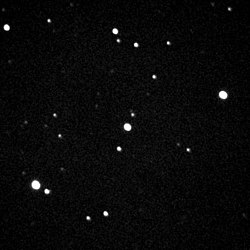 The star WASP-1. | |
| Observation data Epoch J2000 Equinox J2000 | |
|---|---|
| Constellation | Andromeda |
| Right ascension | 00 20 40.0746 |
| Declination | +31° 59′ 23.955″ |
| Apparent magnitude (V) | 11.68 ± 0.05 |
| Characteristics | |
| Spectral type | F7V |
| Apparent magnitude (B) | ~12.0 |
| Apparent magnitude (V) | 11.68 ± 0.05 |
| Astrometry | |
| Radial velocity (Rv) | −13.90(59) km/s |
| Proper motion (μ) | RA: −4.692(22) mas/yr Dec.: −3.320(20) mas/yr |
| Parallax (π) | 2.6108 ± 0.0218 mas |
| Distance | 1,250 ± 10 ly (383 ± 3 pc) |
| Absolute magnitude (MV) | 3.63+0.13 −0.14 |
| Details | |
| Mass | 1.301+0.049 −0.047 M☉ |
| Radius | 1.515+0.052 −0.045 R☉ |
| Luminosity | 2.88+0.36 −0.30 L☉ |
| Surface gravity (log g) | 4.190+0.020 −0.022 cgs |
| Temperature | 6110±75 K |
| Metallicity | 0.26±0.08 dex |
| Age | 3.0±0.6 Gyr |
| Other designations | |
| 1SWASP J002040.07+315923.7, USNO-B1.0 1219-00005465, Gaia DR2 2862548428079638912, TYC 2265-107-1, GSC 02265-00107, 2MASS J00204007+3159239 | |
| Database references | |
| SIMBAD | data |
WASP-1 is a metal-rich magnitude 12 star located about 1,250 light-years away in the Andromeda constellation.
Planetary system
In 2006, an extrasolar planet was discovered by the Wide Angle Search for Planets team using the transit method. The planet has a density of 0.31 to 0.40 g/cm, making it about half as dense as Saturn, and one third as dense as water. The orbit of WASP-1b is inclined to rotational axis of the star by 79.0
−4.5 degrees, making it a nearly "polar" orbit.
Two searches for additional planets using transit-timing variations have yielded negative results.
| Companion (in order from star) |
Mass | Semimajor axis (AU) |
Orbital period (days) |
Eccentricity | Inclination | Radius |
|---|---|---|---|---|---|---|
| b | 0.948+0.029 −0.028 MJ |
0.03958+0.00047 −0.00049 |
2.51994480±0.00000050 | <0.013 | 90.0+0.0 −2.9° |
1.514+0.052 −0.047 RJ |
See also
References
- Roman, Nancy G. (1987). "Identification of a Constellation From a Position". Publications of the Astronomical Society of the Pacific. 99 (617): 695–699. Bibcode:1987PASP...99..695R. doi:10.1086/132034. Vizier query form
- ^ Vallenari, A.; et al. (Gaia collaboration) (2023). "Gaia Data Release 3. Summary of the content and survey properties". Astronomy and Astrophysics. 674: A1. arXiv:2208.00211. Bibcode:2023A&A...674A...1G. doi:10.1051/0004-6361/202243940. S2CID 244398875. Gaia DR3 record for this source at VizieR.
- ^ Torres, Guillermo; Winn, Joshua N.; Holman, Matthew J. (2008). "Improved Parameters for Extrasolar Transiting Planets". The Astrophysical Journal. 677 (2): 1324–1342. arXiv:0801.1841. Bibcode:2008ApJ...677.1324T. doi:10.1086/529429. S2CID 12899134.
- ^ Cameron, A. Collier; et al. (2007). "WASP-1b and WASP-2b: two new transiting exoplanets detected with SuperWASP and SOPHIE". Monthly Notices of the Royal Astronomical Society. 375 (3): 951–957. arXiv:astro-ph/0609688. Bibcode:2007MNRAS.375..951C. doi:10.1111/j.1365-2966.2006.11350.x. S2CID 735515.
- ^ "TYC 2265-107-1". SIMBAD. Centre de données astronomiques de Strasbourg. Retrieved 2009-05-20.
- Stempels, H. C.; et al. (2007). "WASP-1: a lithium- and metal-rich star with an oversized planet". Monthly Notices of the Royal Astronomical Society. 379 (2): 773–778. arXiv:0705.1677. Bibcode:2007MNRAS.379..773S. doi:10.1111/j.1365-2966.2007.11976.x. S2CID 17565024.
- Simpson, E. K.; Pollacco, D.; Cameron, A. Collier; Hébrard, G.; Anderson, D. R.; Barros, S. C. C.; Boisse, I.; Bouchy, F.; Faedi, F.; Gillon, M.; Hebb, L.; Keenan, F. P.; Miller, G. R. M.; Moutou, C.; Queloz, D.; Skillen, I.; Sorensen, P.; Stempels, H. C.; Triaud, A.; Watson, C. A.; Wilson, P. A. (2011). "The spin-orbit angles of the transiting exoplanets WASP-1b, WASP-24b, WASP-38b and HAT-P-8b from Rossiter-Mc Laughlin observations★". Monthly Notices of the Royal Astronomical Society. 414 (4): 3023–3035. arXiv:1011.5664. Bibcode:2011MNRAS.414.3023S. doi:10.1111/j.1365-2966.2011.18603.x. S2CID 46522188.
- Granata, V.; et al. (2014). "TASTE IV: Refining ephemeris and orbital parameters for HAT-P-20b and WASP-1b". Astronomische Nachrichten. 335 (8): 797–803. arXiv:1405.3288. Bibcode:2014AN....335..797G. doi:10.1002/asna.201412072. S2CID 118341059.
- Maciejewski, G.; et al. (2014). "Revisiting Parameters for the WASP-1 Planetary System" (PDF). Acta Astronomica. 64 (1): 11–26. arXiv:1402.6518. Bibcode:2014AcA....64...27M.
- Bonomo, A. S.; et al. (2017). "The GAPS Programme with HARPS-N at TNG . XIV. Investigating giant planet migration history via improved eccentricity and mass determination for 231 transiting planets". Astronomy and Astrophysics. 602. A107. arXiv:1704.00373. Bibcode:2017A&A...602A.107B. doi:10.1051/0004-6361/201629882. S2CID 118923163.
External links
- "Planet WASP-1 b". Extrasolar Planets Encyclopaedia. Retrieved 2018-11-07.
- Image WASP 1
| Constellation of Andromeda | |||||||||||||
|---|---|---|---|---|---|---|---|---|---|---|---|---|---|
| Stars |
| ||||||||||||
| |||||||||||||
| Star clusters |
| ||||||||||||
| Nebulae |
| ||||||||||||
| Galaxies |
| ||||||||||||
| |||||||||||||
| |||||||||||||
This main-sequence-star-related article is a stub. You can help Misplaced Pages by expanding it. |